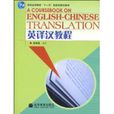內容簡介
《英譯漢教程》將翻譯理論課、技巧課和實踐課融為一體,提供了一套可供課堂操作的英漢翻譯基礎教程。 本教材主要供高等院校英語專業本科高年級或同等程度的學生作為英漢翻譯課在課堂教學中使用,也可供有同等英語水平的翻譯自學者使用。
作者簡介
連淑能(1942-),廈門大學外文學院教授、博士生導師,榮獲國務院頒發的政府特殊津貼。1996—1999年任廈門大學外文系系主任,1999—2003年任外文學院院長,現兼任中國英漢語比較研究會副會長、中國人文社會科學核心期刊《外語與外語教學》顧問和編委等。曾任駐外大使館和專家組翻譯,赴英國牛津大學和劍橋大學、美國俄勒岡大學和威拉姆特大學講學、研究。榮獲福建省“三育人先進個人”稱號、廈門市優秀教師稱號、廈門大學最高獎“南強獎”一等獎(合作)、廈門大學研究生“良師益友”稱號等。主要研究方向為漢英語言與中西文化、翻譯理論與技巧、跨文化交際學,已發表80多篇論文和18部論著、編著、譯著,合作承擔國家863計畫課題“自然語言理解與機器翻譯”,榮獲20多項獎項。代表作《英漢對比研究》榮獲國家教委頒發的第二屆全國高等學校出版社優秀學術著作優秀獎、福建省第三屆社會科學優秀成果一等獎,並被選送參加國際書展。
目錄
Chapter1 GeneraIPrlnclples 1
1.1 What is Translation? 1
1.1.1 Linguistic Views on Translation 1
1.1.2 Cultural Views on Translation 1
1.1.3 Literary Views on Translation 2
1.1.4 Semantic Views on Translation 2
1.1.5 Functional Views on Translation 3
1.1.6 Communicative Views on Translation
1.2 The Assessment of Translation 3
1.2.1 Translation Criteria Put Forward by Famous Translators or Tra
1.2.2 Other Factors Affecting the Evaluation of Translation
1.2.3 Criteria for Beginners of Translation 7
1.2.4 Translation Proficiency: the Requirements of the Teach English Major
1.3 The Competence of a Translator 8
1.3.1 Excellent Command of the Two Languages 8
1.3.2 Considerable Knowledge of the Two Cultures 9
1.3.3 Adequate Knowledge of the Subject Matter 11
1.3.4 Fair Capacity for Writing 11
1.3.5 Plenty of Practice and Adequate Knowledge of Transl Skills 11
1.3.6 Skills in the Use of Information Technology 12
1.4 Translation Strategies 12
1.4.1 Literal Translation and Free Translation 12
1.4.2 Foreignizing Translation and Domesticating Translation
1.4.3 Style and Translation 15
1.5 Basic Processes in Translating 19
1.5.1 The Four-phase Process in Translating 19
1.5.2 Some Dos and Don'ts for Students 21
1.5.3 Procedures of Translation by a Team 21
Chapter 2 Contrastlve Studies of English and Chinese 25
2.1 Studies of the English Language 25
2.1.1 External History: Historical Information Related to the English Language 25
2.1.2 Internal History: a Linguistic Review 28
2.1.3 Some Characteristics of English 29
2.2 Studies of the Chinese Language 31
2.2.1 Some Major Factors Affecting the Chinese Language 31
2.2.2 Some Characteristics of Modern Chinese 32
2.3 English vs. Chinese: Ten Pairs of Features 38
2.3.1 Synthetic vs. Analytic (綜合語與分析語) 38
2.3.2 Rigid vs. Supple (剛性與柔性) 44
2.3.3 Hypotactic vs. Paratactic (形合與意合) 47
2.3.4 Complex vs. Simplex (繁複與簡短) 49
2.3.5 Impersonal vs. Personal (物稱與人稱) 50
2.3.6 Passive vs. Active (被動與主動) 52
2.3.7 Static vs. Dynamic (靜態與動態) 54
2.3.8 Abstract vs. Concrete (抽象與具體) 55
2.3.9 Indirect vs. Direct (間接與直接) 56
2.3.10 Substitutive vs. Repetitive (替換與重複) 59
Conclusion 66
Chapter3 DIction(選詞法) 67
3.1 Choice of Affective Meanings 67
3.2 Choice of Grammatical Meanings 70
3.3 Choice of Contextual Meanings 71
3.4 Choice of Collocative Meanings 72
3.5 Choice of Stylistic Meanings 74
3.6 Choice of Ambiguous Meanings 81
3.7 Choice of Extended Meanings 83
3.8 Choice of Equivalent Meanings 87
3.9 Choice of Exact Meanings 92
3.10 Choice of Different Chinese Words to Translate the Same English Word or Use of the
Same Chinese Word(s) to Translate Different English Words 95
Conclusion 102
Chapter 4 Conversion(轉換法) 103
4.1 Conversion of Word Classes 103
4.2 Conversion of Sentence Members 1 14
4.3 Conversion of Impersonal Subjects 1 18
4.4 Conversion of Perspectives 125
Conclusion 1 28
Chapter 5 Addltion(增神法) 129
5.1 Structural Addition 129
5.2 Semantic Addition 130
5.3 RhetoricaI Addition 140
Conclusion 1 44
Chapter 6 Omission(省略法) 146
6.1 Omission of Words Peculiar to English 146
6.2 Omission of Words Superfluous in Chinese 149
Conclusion 1 62
Chapter 7 Repetition(重複法) 164
7.1 Grammatical Repetition 1 65
7.2 Rhetorical Reduplication and Repetition 170
Conclusion 1 83
Chapter 8 Invorslon(倒置法) 164
8.1 Inversion of Word Order in Translating Word-Groups or Phrases 184
8.2 Inversion of Word Order in Translating Attributes 185
8.3 Position of Adjective Clauses 188
8.4 Inversion of Adverbials 1 93
8.5 Position of Adverbial Clauses 194
8.6 Inversion of Sentence Structure 196
rnnchLlsinn 205
Chapter 9 Negation (反譯法) 208
9.1 Transfer of the Negative 208
9.2 Conversion of the Affirmative into the Negative 211
9.3 Conversion of the Negative into the Affirmative 213
9.4 Translation of English Questions and Answers 216
9.5 Translation of Various Kinds of Negations 220
Conclusion 251
Chapter10 Dlvlslon(拆譯法) 252
10.1 Picking Out of Words 252
10.2 Picking Out of Phrases 254
10.3 Splitting of Complex Sentences 256
10.4 Splitting of the Whole Sentence 262
Conclusion 268
Chapter11 Condensation(縮譯法) 270
11.1 Condensation of Phrases and Clauses 270
11.2 Condensation of Complex Sentences into Simple Sentences 271
11.3 Condensation of Compound Sentences into Simple Sentences 273
11.4 Condensation of Two or More Simple Sentences into One Simple Sentence 273
Conclusion 276
Chapter 12 Translation of the Passive(被動與譯法) 277
12.1 Features of the English Passive 277
12.2 Features of the Chinese Passive 279
12.3 Common Ways to Translate the English Passive 282
Conclusion 289
Chapter 13 Translation of Long Sentences(長句譯法) 290
13.1 Features of Long English Sentences 290
Chapter 14 Translation of Culture-loaded Expressions
Chapter 15 Transaltion of Proper Nouns and Technical Terms
……

